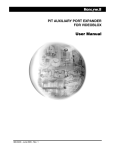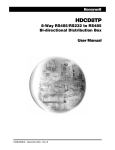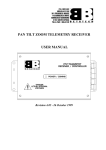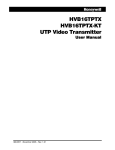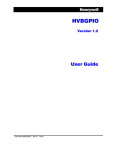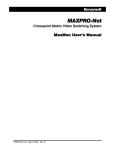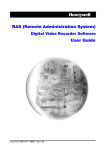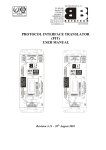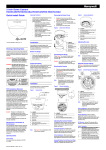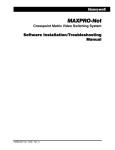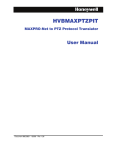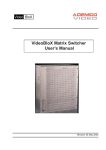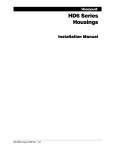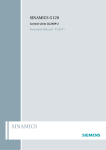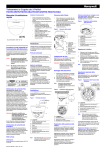Download Auxiliary Control Interface Protocol Definition for VideoBlox Rev. III
Transcript
Auxiliary Control Interface Protocol Definition for VideoBlox Rev. III User Manual 900.0401 - June 2005 - Rev. 1 ISSUE DATE 1 June 2005 Rev. 1 REVISIONS Initial Release ii 900.0401 17-June-05 LIST OF ABBREVIATIONS Rev. 1 LED Light Emitting Diode – i.e. status indication MVT Multi-channel Video Titling unit PCK Programmable Control Keyboard PTZ Pan/Tilt/Zoom equipped camera iii 900.0401 17-June-05 TABLE OF CONTENTS 1.1 INTRODUCTION.................................................................................................................................. 1 2.1 PROTOCOL DEFINITION .................................................................................................................... 1 2.1.1 Data Format ..................................................................................................................... 1 2.1.2 Command Set .................................................................................................................. 1 2.1.3 PTZ Command Description ............................................................................................. 2 2.1.4 Read Status Command Description ................................................................................ 3 2.1.5 Read Alarms / Videos Command Description ................................................................. 3 3.1 CONNECTIONS .................................................................................................................................. 4 3.1.1 RS232 Option................................................................................................................... 4 3.1.2 RS422 Option................................................................................................................... 4 4.1 EXAMPLES.......................................................................................................................................... 5 Rev. 1 iv 900.0401 17-June-05 1.1 INTRODUCTION This document describes the command set which has been implemented into the Betatech Surveillance Mate Master Series Revision III matrix switcher. The purpose of this command set, is to allow third party developers to readily access certain functionality of the matrix switcher. 2.1 PROTOCOL DEFINITION 2.1.1 Data Format The data format is fixed at 9600 baud, 8 data bits, 1 stop bit, no parity. All commands consist of a text string which is not case insensitive. This is followed by a variable number of parameters, separated by commas, depending on the command. The command must be terminated with a carriage return (0x0D). Should the command format be acceptable, a carriage return, line feed and command prompt will be returned. Should the command format not exactly match the expected commands, the command will be ignored and a carriage return, line feed, “???”, followed by the response had the command been accepted. On power up the matrix will transmit a similar string to the following out of the auxiliary port: Betatech SoftCPU Revision 3.17a All rights reserved 1998 SoftCPU> 2.1.2 Command Set Command Parm 1 Parm 2 SWITCH Input Output Switch video input to output PTZRCL PTZ Address Position Recall PTZ pre-positions PTZSTOR PTZ Address Position Store PTZ pre-positions PTZAUX PTZ Address Aux number State Set / Clear PTZ Auxiliary outputs PTZC PTZ Address Function Parameter Operate PTZ, see description below PTZ Function Parameter Operate PTZ, see description below KBALARM PCK Address State PCK alarm indication KBLED PCK Address LED number Rev. 1 Parm 3 State 1 Comments PCK LED indications 900.0401 17-June-05 2.1.2 Command Set, Continued Command Parm 1 Parm 2 Parm 3 Comments KBTEXT PCK Address ASCII text RUNSEQ Sequence number Sequence parameter STOPSEQ Sequence number DISPLAY Channel number CLRSCR Channel number CLRLINE Channel number OUTPUT System output number State Operation of system outputs SETDATE dd/mm/yy Set date SETTIME hh/mm/ss Set time Put text string on PCK display Default monitor Operation of sequences Operation of sequences Line number Text string Put text string on MVT Clear screen on MVT Line number Clear line on MVT REV Read matrix software revision ALARM? Alarm number Return status of alarm input VIDEO? Video input number Return status of video input MATRIX? Video output number ALARMS? Read all alarm inputs Return input channel routed to this output Return number & status of alarms VIDEOS? Return number & status of video SIZING? Return system size information HELP Display a list of available commands 2.1.3 PTZ Command Description The command “PTZ” allows for control of pan / tilt and zoom operation. Whenever a “SWITCH” command is carried out, the system “remembers” which video monitor has been selected, and the input which is routed to this monitor. All subsequent PTZ control operation will use the camera input channel which is currently routed to this monitor output. The PTZC command uses the camera number instead of the keyboard. When a keyboard “PTZ” command is used, the SoftCPU takes care of automatically retransmitting information to the selected PTZ. This is NOT done with the “PTZC” command and to keep the PTZ operating continuously, it may be necessary to send repeat messages at a rate higher than once per second. Rev. 1 2 900.0401 17-June-05 2.1.3 PTZ Command Description, Continued Parm 1 Parm 2 Comments 0 Don’t care 1 Speed Set Pan speed (right for speed > 0) 2 Speed Set Tilt speed (up for speed > 0) 3 Direction Set zoom (zoom in for direction > 0) 4 Direction Set focus (focus near for direction > 0) 5 Direction Set Iris (iris open for direction > 0) 6 Lens Stop pan and tilt operation (no change to lens drive) Lens packed as described below (only for PTZC) The “Speed” parameter must be in the range –127 to + 127. A value of 0 stops the pan or tilt drive. The “Direction” parameter must be in the range –127 to +127. Currently only fixed speed commands are implemented, so only the sign is relevant. A value of zero stops the lens drive. For the “packed” lens control function, the functions of the lens control byte are as follows: 2.1.4 Bit 5 Bit 4 Bit 3 Bit 2 Bit 1 Bit 0 Iris Close Iris Open Zoom Out Zoom In Focus Far Focus Near Read Status Command Description The commands “REV”, “ALARM?”, “VIDEO”, and “MATRIX?” all request data from the matrix. In all cases a carriage return, line feed, followed by the requested information, another carriage return, line feed and the command prompt will be returned. If the requested parameter is out of range a “0” will be returned. 2.1.5 Read Alarms / Videos Command Description The commands “ALARMS?” and “VIDEOS?” return the number of channels configured, followed by cr/lf and a block of data representing the status, a ‘^’ and then the exclusive-or checksum of the video / alarm status. Rev. 1 3 900.0401 17-June-05 3.1 CONNECTIONS The third party interface is implemented on the video matrix SoftCPU “COM4” serial communications port. This port may have either RS232 or RS422 option boards installed. 3.1.1 RS232 Option Pin Number 3.1.2 Pin Function 1 Internally Connected to pins 4 and 6 2 RXD (data from slave device TXD) 3 TXD (data to slave device RXD) 4 Internally Connected to pins 1 and 6 5 GND (RS232 Communications common) 6 Internally Connected to pins 1 and 4 7 CTS (from slave device RTS) 8 RTS (to slave device CTS) 9 N/C RS422 Option Pin Number Rev. 1 Pin Function 1 RS422 Receive data [-] 2 RS422 Receive data [+] 3 RS422 Transmit data [+] 4 RS422 Transmit data [-] 5 RS422 Communications common 6 N/C 7 N/C 8 N/C 9 N/C 4 900.0401 17-June-05 4.1 EXAMPLES Note that in the following examples “\r”, denotes a carriage return representing 0x0D. Example 1: Switch video matrix input 15 to video output 7: SWITCH 15,7\r Example 2: Cause the PTZ camera connected to input 15 to move to preset position 1: PTZRCL 15,1 \r Example 3: Store the current position of the PTZ camera connected to input 12 as preset position 5: PTZSTOR 12,5\r Example 4: Operate the pan function of the PTZ camera routed to output 7 (because of example 1, this is the currently “active” monitor, which currently has PTZ camera 15 routed to it). The PTZ will move at full speed to the left. PTZ 1,-127\r Example 5: Display the text string “Hello World” on line 5 on the titler connected to video input 15. DISPLAY 15,5,Hello World\r Example 6: Turn off system output 1: OUTPUT 1,0\r Example 7: Start sequence 5. The parameter which is passed to the sequence is 100 and the default monitor for the sequence is 1. RUNSEQ 5,100,1\r Example 8: Stop the above sequence. STOPSEQ 5\r Example 9: Set the system date and time to 3:22 pm on 15 January 1998: DATE 15/01/98\r TIME 15:22:00\r Rev. 1 5 900.0401 17-June-05 Example 10: Read the software revision in the matrix. REV\r The matrix switcher will return something like: \n\r 3.17a \n\r SoftCPU> Example 11: Read the current alarm status for alarm input 200. ALARM? 200\r The matrix switcher will return something like: \n\r 1 \n\r SoftCPU> The “1” indicates that this alarm contact is closed Example 12: Read the video input status for input 321. VIDEO? 321\r The matrix switcher will return something like: \n\r 1 \n\r SoftCPU> The “1” indicates that video is present on this input. Example 13: Read alarm status. ALARMS? The matrix switcher will return something like: \n\r 32\n\r 01000000^01 \n\r The 32 is the number of alarms configured. Note that the length of the reply packet will vary dependant on the configuration. The first two bytes of the alarm status “01”, show that only alarm input 1 is active. “02” would be alarm 2 active, “03” both alarm 1 and 2. The block of data is similar to a hexadecimal dump of the alarm status. The “^” character indicates the end of data and the fact that the checksum will follow. The last 2 bytes are the exclusive-or checksum of the data portion of the reply. Rev. 1 6 900.0401 17-June-05 Example 14: Read system sizing. SIZING? The matrix switcher will return something like: \n\r 128 Cameras\n\r 032 Monitors\n\r 128 Alarms\n\r Rev. 1 7 900.0401 17-June-05 Honeywell Video Systems (Head Office) 2700 Blankenbaker Pkwy, Suite 150 Louisville, KY 40299 www.honeywellvideo.com TEL+1-800-796–2288 Honeywell Security Australia Pty Ltd. Unit 5, Riverside Centre, 24-28 River Road West Parramatta, NSW 2150, Australia www.ademco.com.au TEL +61-2-8837-9300 Honeywell Video Systems UK Ltd. Aston Fields Road, Whitehouse Ind Est Runcorn, Cheshire, WA7 3DL, UK www.security.honeywell.com TEL +44-1928-754-000 Honeywell Security Asia Pacific Flat A, 16/F, CDW Building, 388 Castle Peak Road Tsuen Wan, N.T., Hong Kong www.security.honeywell.com/hk TEL +852-2405-2323 Honeywell Security South Africa Unit 6 Galaxy Park, Galaxy Avenue, Linbro Business Park P.O. Box 59904, Kengray, 2100, South Africa www.honeywell.co.za TEL +27-11-574-2500 Honeywell Security France Parc Gutenberg, 13, Voie La Cardon 91120, Palaiseau, France www.ademco.fr TEL +33-1-6932-1090 Honeywell Security Germany Großenbaumer Weg 8 40472 Düsseldorf, Germany www.honeywell-security.de TEL +49-211-415-090 Honeywell Security Italia SpA Via della Resistenza 53/59, 20090 Buccinasco Milan, Italy www.ademco.it TEL +39-02-457-1791 Honeywell Security Poland Chmielewskiego 22a, 70-028 Szczecin, Polska www.ultrak.pl TEL +48-91-485-40-60 Honeywell Security Espana Calle Vivero, 5, 28040 Madrid, Spain www.ademco.es TEL +34-91-533-4706 Honeywell Security Czech Republic Havránkova 33, Brno Dolní Heršpice, 619 00, Czech Republic www.olympo.cz TEL +420-543-558-111 Honeywell Security House (Netherlands) Amperestraat 41 1446 TR Purmerend, Netherlands www.SecurityHouse.nl TEL +31-299-419-000 Honeywell Security Slovakia Republic Vajnorskà 142, 83104 Bratislava Slovakia www.olympo.sk TEL +421-2-444-54-660 Video Systems www.honeywellvideo.com 1-800-796-CCTV (North America only) © 2005 Honeywell International Inc. All rights reserved. No part of this publication may be reproduced by any means without written permission from Honeywell Video Systems. The information in this publication is believed to be accurate in all respects. However, Honeywell Video Systems cannot assume responsibility for any consequences resulting from the use thereof. The information contained herein is subject to change without notice. Revisions or new editions to this publication may be issued to incorporate such changes.












